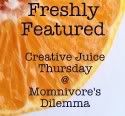 I found this little bit of random info about yeast interesting..."Yeast... is used in baking as a leavening agent, where it converts the fermentable sugars present in dough into the gas carbon dioxide. This causes the dough to expand or rise as gas forms pockets or bubbles. When the dough is baked, the yeast dies and the air pockets "set", giving the baked product a soft and spongy texture. The use of potatoes, water from potato boiling, eggs, or sugar in a bread dough accelerates the growth of yeasts." -Wikipedia
I found this little bit of random info about yeast interesting..."Yeast... is used in baking as a leavening agent, where it converts the fermentable sugars present in dough into the gas carbon dioxide. This causes the dough to expand or rise as gas forms pockets or bubbles. When the dough is baked, the yeast dies and the air pockets "set", giving the baked product a soft and spongy texture. The use of potatoes, water from potato boiling, eggs, or sugar in a bread dough accelerates the growth of yeasts." -WikipediaMel's Kitchen Cafe has an awesome tutorial on baking with yeast and it helped me sooo much! Go HERE to see that. I highly recommend it. I also found good tips at The Reluctant Gourmet.

Some of the tips I have learned and found most useful from these places and from my own practice are the following...
1) Instant yeast is a good option for beginners. I love not having to wait for my active dry yeast to proof before adding it.
2) Get your water at the right temperature. If it's too hot, it will kill the yeast. If it's too cold, the yeast won't work. My rule is to test using my wrist... I like it to be warmer than bath water but not hot enough to burn.
3) The amount of flour used in a recipe is just a basic guideline. I always thought you should follow the recipe exactly but when it comes to bread, it's important to not over flour your dough.
4) Good supplies for bread making... If you plan on making bread a lot, a mixer is a lifesaver! I LOVE LOVE LOVE my Bosch. I never knew just how wonderful it really was until I made bread. I also think that having silpat liners are wonderful.
5) Kneading the dough is very important. It takes a lot of kneading to develop the gluten. That's why the bosch is so handy! Kneading by hand can be quite therapeutic though.
6) The main ingredients for bread are... Water, yeast, flour, salt. Many recipes call for extras like eggs, milk, and vital wheat gluten. Want to know what happens to your bread when you add these? Go HERE to find out!
7) Let your bread rise in a warm place. Ben used to warm up our oven on the lowest temperature and stick it in there... it was way too hot and started cooking the bread. I put mine in a sunny place in my house with no drafts.
8) I make a batch of bread that is usually 4-6 loaves and then place the rest in plastic bread bags and freeze.
 Since learning to use yeast, I have made the following: Lion House Rolls (my favorite!), bagels, bread bowls, another roll recipe, three different recipes for whole wheat bread, breadsticks, and pita wrap bread. Can you tell how much I love Mel's Kitchen Cafe? :) I loved all these recipes and have decided to try making all of our families bread items from now on. No more expensive old bread at the grocery store for us! Yay! Baking bread has become one of my favorite new hobbies. I hope these tips and tricks helped inspire you to try it out as well. Happy Baking!
Since learning to use yeast, I have made the following: Lion House Rolls (my favorite!), bagels, bread bowls, another roll recipe, three different recipes for whole wheat bread, breadsticks, and pita wrap bread. Can you tell how much I love Mel's Kitchen Cafe? :) I loved all these recipes and have decided to try making all of our families bread items from now on. No more expensive old bread at the grocery store for us! Yay! Baking bread has become one of my favorite new hobbies. I hope these tips and tricks helped inspire you to try it out as well. Happy Baking!






Thanks for the tips! Your Rolls and Bread look FABULOUS! Can't wait to practice some with my bread-making...
ReplyDeleteYum. I. LOVE. Bread. Thanks for the tips. Homemade bread has always intimidated me, no more excuses.
ReplyDelete